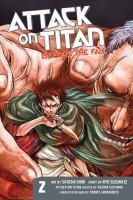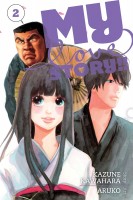My News and Reviews
Last week Experiments in Manga saw the introduction of a new feature—Adaptation Adventures. Basically, the feature is intended to explore and compare different versions of the same story, which I think should be an interesting approach. I specifically had things in mind like the Parasyte anime adaptation that recently began airing (readers of Experiments in Manga have expressed interest in some sort of Parasyte comparison in the past), but I quickly realized that the feature provides nearly endless options. For the first Adaptation Adventures column, I took a look at Udon Entertainment’s Manga Classics, a line of manga-style graphic novel adaptations of classic literature. I was pleasantly surprised by the Manga Classics editions of Pride & Prejudice and Les Misérables and look forward to seeing future releases. I also posted an in-depth manga review last week of Yaya Sakuragi’s Bond of Dreams, Bond of Love, Volume 4, the last volume in the series. Sakuragi was my introduction to boys’ love manga and I’m always happy to see more of her work available in English. Bond of Dreams, Bond of Love isn’t my favorite Sakuragi manga, but I did enjoy its goofiness.
Elsewhere online, I was extremely happy to see that the one and only Manga Critic (Katherine Dacey) has come out of “retirement” and joined forces with Brigid Alverson at MangaBlog. Kate was one of my major inspirations for starting Experiments in Manga, so I’m very happy to see her return and look forward to reading her commentary. This also means that MangaBlog will be updated more regularly again, which will be great. In other news: Sean Gaffney at A Case Suitable for Treatment has a roundup of Seven Seas recent license announcements. Over at Comics Forum, the most recent Manga Studies column has been posted—Takeuchi Osamu and Manga Expression pt. 1: Tezuka Osamu as Manga Locus by Nicholas Theisen. Also, October’s issue of Sparkler Monthly is now available. It includes the launch of the third and final volume of Tokyo Demons as well as some additional bonus stories for the series. (Since I love Tokyo Demons, I’m particularly excited for and dreading the beginning of the end.)
The New York Comic Con took place over the weekend, and there was plenty of excitement to come out of that. Sean was there this year and has written up some notes on the panels he was able to attend. Vertical is spinning off Vertical Comics as a separate imprint to focus on manga and related material while Vertical continues to release prose and nonfiction. Vertical also licensed more Attack on Titan light novels, which will probably do pretty well. Viz Media also had a few new licenses to announce, as did Kodansha Comics. In addition to several other licenses, Yen Press has rescued Kaoru Mori’s Emma for a deluxe hardcover omnibus release! I only discovered Emma after CMX’s edition went out of print (and became extremely expensive), so I’m thrilled that I’ll finally be able to own the series in such a lovely format. (If you’re curious about Emma, I recommend checking out the archives for the Emma Manga Moveable Feast.)
Quick Takes
 Attack on Titan: Before the Fall, Volume 2 written by Ryo Suzukaze and illustrated by Satoshi Shiki. I have largely been enjoying Attack on Titan‘s prequel manga Before the Fall, but I think I like it even more now that I have read the first Before the Fall novel that was recently released by Vertical. (My review of that volume can be found here.) Other than both being prequels to Attack on Titan, the stories of the novel and the manga aren’t directly related, but small references are made to the novel’s plot and characters in the manga. Which makes a fair amount of sense since the Before the Fall manga series is based on the second and third Attack on Titan light novels written by Suzukaze. In the second volume of the Before the Fall manga, Kuklo and Sharle have made their escape—Kuklo from the dungeons and Sharle from her overbearing father—but they are now faced with surviving among the common people. They actually make a pretty good life for themselves at first, but then Kuklo becomes obsessed with wanting to see a Titan for himself which, as anyone who is familiar with Attack on Titan will know, is an absolutely terrible idea that probably won’t end well for anyone involved.
Attack on Titan: Before the Fall, Volume 2 written by Ryo Suzukaze and illustrated by Satoshi Shiki. I have largely been enjoying Attack on Titan‘s prequel manga Before the Fall, but I think I like it even more now that I have read the first Before the Fall novel that was recently released by Vertical. (My review of that volume can be found here.) Other than both being prequels to Attack on Titan, the stories of the novel and the manga aren’t directly related, but small references are made to the novel’s plot and characters in the manga. Which makes a fair amount of sense since the Before the Fall manga series is based on the second and third Attack on Titan light novels written by Suzukaze. In the second volume of the Before the Fall manga, Kuklo and Sharle have made their escape—Kuklo from the dungeons and Sharle from her overbearing father—but they are now faced with surviving among the common people. They actually make a pretty good life for themselves at first, but then Kuklo becomes obsessed with wanting to see a Titan for himself which, as anyone who is familiar with Attack on Titan will know, is an absolutely terrible idea that probably won’t end well for anyone involved.
 My Love Story!!, Volume 2 written by Kazune Kawahara and illustrated by Aruko. I absolutely adored the first volume of My Love Story!!, so much so that I was actually a little afraid to read the second volume since my expectations had been set so high. However, I am very pleased to report that I also loved My Love Story!!, Volume 2. The entire series just makes me so extremely happy to read. Takeo and Yamato’s love is incredibly pure and sweet and the two of them are utterly endearing and charming together. Misunderstandings do happen on occasion, but forgiveness is quick in coming and no harm is done. My Love Story!! has the potential to be sickeningly sweet, but the romance and characters are handled with such humor and lightheartedness that, at least for me, the manga hasn’t reached that point. There isn’t much nuance or subtlety to the characters—Takeo is a manly many with a sensitive heart, Yamato is adorable and earnest, Suna is cool and aloof—but I like them all so much that I don’t mind. My Love Story!! is ridiculous and over-the-top and I love it. I’m still not sure how the story will be able to be sustained for an entire series now that the basic conceit has been so well-established, but I look forward to finding out.
My Love Story!!, Volume 2 written by Kazune Kawahara and illustrated by Aruko. I absolutely adored the first volume of My Love Story!!, so much so that I was actually a little afraid to read the second volume since my expectations had been set so high. However, I am very pleased to report that I also loved My Love Story!!, Volume 2. The entire series just makes me so extremely happy to read. Takeo and Yamato’s love is incredibly pure and sweet and the two of them are utterly endearing and charming together. Misunderstandings do happen on occasion, but forgiveness is quick in coming and no harm is done. My Love Story!! has the potential to be sickeningly sweet, but the romance and characters are handled with such humor and lightheartedness that, at least for me, the manga hasn’t reached that point. There isn’t much nuance or subtlety to the characters—Takeo is a manly many with a sensitive heart, Yamato is adorable and earnest, Suna is cool and aloof—but I like them all so much that I don’t mind. My Love Story!! is ridiculous and over-the-top and I love it. I’m still not sure how the story will be able to be sustained for an entire series now that the basic conceit has been so well-established, but I look forward to finding out.
 A New Season of Young Leaves written by Venio Tachibana and illustrated by Akeno Kitahata. Ever since reading the two-volume boys’ love manga series Seven Days (which I loved) I have made a point to seek out more of Tachibana’s work available in English. And so I was very excited when A New Season of Young Leaves was licensed. I’ll admit, at first I was actually a little disappointed with A New Season for Young Leaves. I simply didn’t understand the relationship and odd power dynamics between the super popular Mariya and the socially awkward Nachi. But then about halfway through the volume, during an extensive flashback that explores the evolution of their strange friendship, the manga finally clicked for me. I found it to be incredibly compelling and I immediately wanted to read it again, which I take as a very good sign. I didn’t realize it when I initially began reading A New Season for Young Leaves, but it’s actually the first manga in a series that is at least three volumes long. While there were definitely a few plot lines introduced that were left unresolved, for the most part A New Season of Young Leaves does tell a complete story. But I really do hope more of the series is licensed; I am very curious to see how things continue to develop between Mariya and Nachi and the rest of their classmates.
A New Season of Young Leaves written by Venio Tachibana and illustrated by Akeno Kitahata. Ever since reading the two-volume boys’ love manga series Seven Days (which I loved) I have made a point to seek out more of Tachibana’s work available in English. And so I was very excited when A New Season of Young Leaves was licensed. I’ll admit, at first I was actually a little disappointed with A New Season for Young Leaves. I simply didn’t understand the relationship and odd power dynamics between the super popular Mariya and the socially awkward Nachi. But then about halfway through the volume, during an extensive flashback that explores the evolution of their strange friendship, the manga finally clicked for me. I found it to be incredibly compelling and I immediately wanted to read it again, which I take as a very good sign. I didn’t realize it when I initially began reading A New Season for Young Leaves, but it’s actually the first manga in a series that is at least three volumes long. While there were definitely a few plot lines introduced that were left unresolved, for the most part A New Season of Young Leaves does tell a complete story. But I really do hope more of the series is licensed; I am very curious to see how things continue to develop between Mariya and Nachi and the rest of their classmates.










